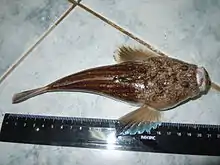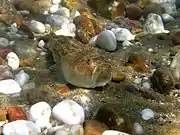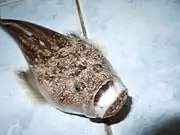| Atlantic stargazer | |
|---|---|
 | |
| Atlantic stargazer from the Black Sea | |
| Scientific classification | |
| Domain: | Eukaryota |
| Kingdom: | Animalia |
| Phylum: | Chordata |
| Class: | Actinopterygii |
| Order: | Trachiniformes |
| Family: | Uranoscopidae |
| Genus: | Uranoscopus |
| Species: | U. scaber |
| Binomial name | |
| Uranoscopus scaber | |
| Synonyms[2] | |
| |
The Atlantic stargazer (Uranoscopus scaber) is a marine, subtropical fish of family Uranoscopidae. Its body is suited for living on the sea floor, and is one of few fish capable of bioelectrogenesis, or the ability to generate an electric charge.
Distribution and habitat
It is widespread along the Atlantic coast of Europe and Africa, is very common in the Mediterranean and Black Sea, and somewhat rare in the Bay of Biscay.[3] It is a demersal fish, which lives in sandy or muddy sand sediments along the upper slope of the continental shelf, between depths of 14–400 meters.[4] It is not an economically important fish, primarily caught as by-catch, but is ecologically important.[5]
Description
Typical of stargazers, its body is somewhat dorso-ventrally flattened, lacks a swimbladder,[6] and has been found as large as 35.0 centimeters in length, but is usually between 20 and 30 cm.[5] Its head and jaws are rotated upward, and has very large eyes and mouth. Its body is brown in color and can have numerous small light spots, with a lighter belly. It lives to about 5 or 6 years, and females are larger in size than males.[7]
Biology
Feeding
Like other stargazers, it is an ambush predator which lies buried under sand with only its eyes showing. It has a large mouth, with a small strip of skin protruding from its lower jaw, which it moves in and out rapidly to act as a lure for prey. When a prey item comes near, the fish lunges toward the prey using a specially adapted vertebral column to generate the force by bending 60°, which takes less than 30 milliseconds to engulf the prey.[8] It feeds primarily on fish larvae and smaller fishes, such as gobies, picarels, and small crustaceans,[9] but has also been known to eat molluscs, echinoderms, annelids, algae and plant material.[10]
Reproduction
They can spawn between April and September, depending on the region, and produce pelagic eggs, about 2 millimeters in diameter. After hatching, the larvae, post-larvae, and juveniles remain pelagic. Males are slightly more common than females, but this can vary within local populations.[4]
Electric organ
All species within the genus Uranoscopus, along with those in Astroscopus, have evolved electric organs, but lack receptor organs. These were both independently evolved, and are the only two genera within the order Perciformes to produce electric organ discharges (EODs). The Atlantic stargazer, like other bioelectrogenic stargazers, produces pulse-type EODs while feeding and when it is disturbed. The Atlantic stargazer produces EODs with the electric organ, derived from sonic muscles.[11] In other fishes, sonic muscles are used to produce sound by agitating the swim bladder.
References
- ↑ Carpenter, K.E.; Smith-Vaniz, W.F.; de Bruyne, G.; de Morais, L. (2015). "Uranoscopus scaber". IUCN Red List of Threatened Species. 2015: e.T198722A42691994. doi:10.2305/IUCN.UK.2015-4.RLTS.T198722A42691994.en. Retrieved 20 November 2021.
- ↑ Eschmeyer, William N.; Fricke, Ron & van der Laan, Richard (eds.). "Species related to Uranoscopus scaber". Catalog of Fishes. California Academy of Sciences. Retrieved 23 June 2018.
- ↑ "Uranoscopus scaber, Stargazer : fisheries, gamefish". www.fishbase.se. Retrieved 2021-10-10.
- 1 2 Coker, T.; O. Akyol; O. Ozaydin; S. Leblebici; Z. Tosunoglu (2008). "Determination of batch fecundity in Uranoscopus scaber Linnaeus, 1758 from the Aegean Sea, Turkey". Journal of Applied Ichthyology. 24: 85–87. doi:10.1111/j.1439-0426.2007.01035.x.
- 1 2 Demirhan, S.A.; M.F. Can; K. Seyhan (2007). "Age and growth of stargazer (Uranoscopus scaber L., 1758) in the southeastern Black Sea". Journal of Applied Ichthyology. 23 (6): 692–694. doi:10.1111/j.1439-0426.2007.00863.x.
- ↑ Young, John (1930). "On the autonomic nervous system of the teleostean fish Uranoscopus scaber". Quarterly Journal of Microscopical Science. 72: 492–535.
- ↑ Rizkalla, Samir I.; Shnoudy A. Bakhoum (2009). "Some biological aspects of the Atlantic stargazer Uranoscopus scaber Linnaeus, 1758 (Family: Uranoscopidae) in the Egyptian Mediterranean water". Turkish Journal of Fisheries and Aquatic Sciences. 9: 59–66.
- ↑ Huet, Laurence; Veronique Goosse; Eric Parmentier; Pierre Vandewalle (1999). "About some skeletal particularities of the first vertebrae related to the mode of prey capture in Uranoscopus scaber (Uranoscopidae)". Cybium. 23 (2): 161–167.
- ↑ Young, John (February 1931). "The pupillary mechanism of the teleostean fish Uranoscopus scaber". Proceedings of the Royal Society B: Biological Sciences. 107 (753): 464–485. doi:10.1098/rspb.1931.0009.
- ↑ Rizkalla, Samir I.; Amal I. Philips (2008). "Feeding habits of the Atlantic stargazer fish Uranoscopus scaber Linnaeus, 1758 (Family: Uranoscopidae) in Egyptian Mediterranean waters". Egyptian Journal of Aquatic Biology and Fisheries. 12 (1): 1–11. doi:10.21608/ejabf.2008.1967.
- ↑ Alves-Gomes, J.A. (2001). "The evolution of electroreception and bioelectrogenesis in teleost fish: a phylogenetic perspective". Journal of Fish Biology. 58 (6): 1489–1511. doi:10.1006/jfbi.2001.1625.


